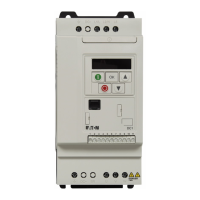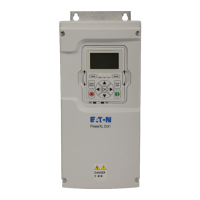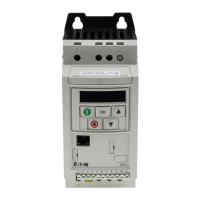4 Operation
4.3 Commissioning with control signal terminals (default settings)
DC1 variable frequency drive 12/13 MN04020003Z-EN www.eaton.com 87
The frequency is shown with a minus sign with a start release with a left
rotating field (REV).
You can now set the output frequency (0 - 50 Hz) and, as a result, the
speed of the connected three-phase motor (0 - n
Motor
), by using the
potentiometer via terminal 6 (0 - +10 V proportional voltage signal). The
change in output frequency here is delayed based on the specified accel-
eration and deceleration ramps. When using the device's default
settings, these times will be set to 5 seconds.
The acceleration and deceleration ramps specify the time change for the
output frequency: from 0 to f
max
(WE = 50 Hz) or from f
max
back to 0.
Figure on Page 87 shows a good example of the process, if the release
signal (FWD/REV) is switched on and the maximum setpoint voltage (+10 V)
is applied. The speed of the motor follows the output frequency depending
on the load and moment of inertia (slip), from zero to n
max
.
If the release signal (FWD, REV) is switched off during operation, the inverter
is blocked immediately (STOP). The motor comes to an uncontrolled stop
(see in Figure).
The acceleration time is set in parameter P-03.
Information on settings and the description of the parameters used here is
provided in section “Drives control”, Page 105.
Figure 57: Start-Stop command with maximum setpoint value voltage, acceleration ramp 5 s
t
t
f
max
~ n
max
f
P-03 = 5 s
FWD
REV
+24 V
= 50 Hz
0
P-07
①
RUN STOP

